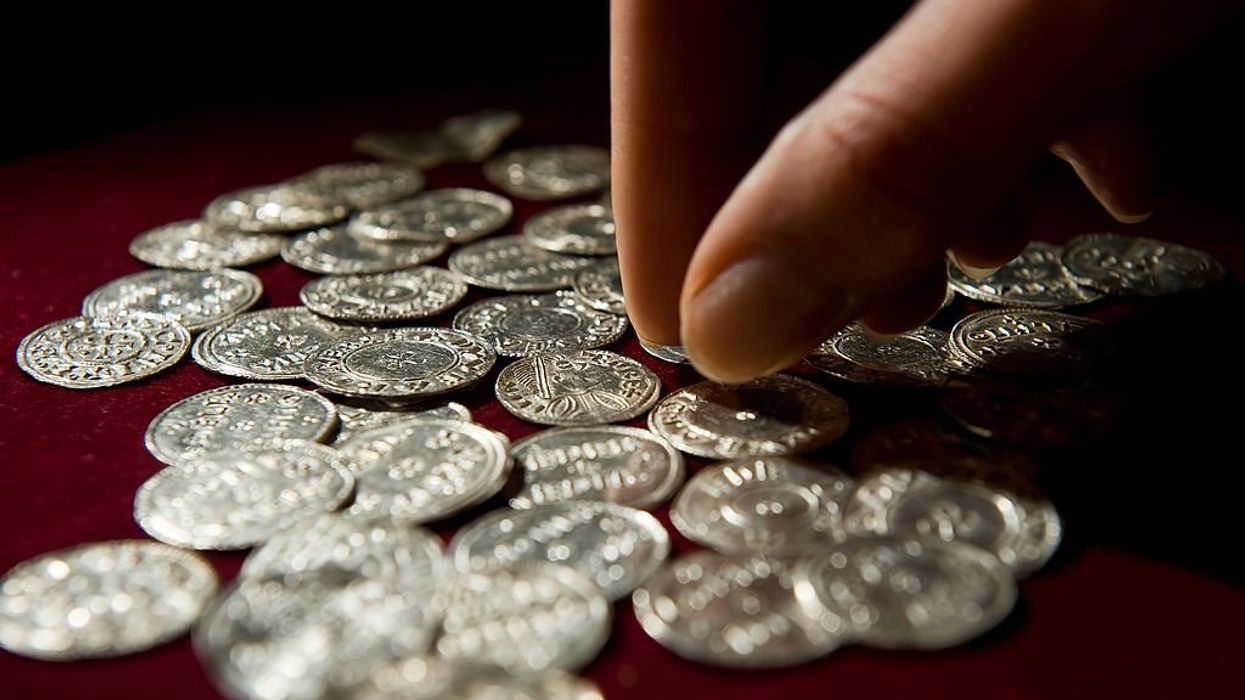
LEON NEAL/AFP via Getty Images

Nearly 300 silver coins believed to be more than 1,000 years old were discovered near a Viking fortress in northwestern Denmark. The trove was unearthed by a young girl who was metal detecting in a cornfield last fall.
There were two treasure sites buried approximately 150 feet from each other near the Fyrkat Viking fortress in the town of Hobro in Denmark. The trove contained over 300 items, including Danish, German, and Arab coins.
\u201cYoung metal detectorist discovers 1,000-year-old Viking coins in Denmark https://t.co/wgly0kl70A\u201d— CTV News (@CTV News) 1682198120
There were also decorated silver balls and cut-up silver jewelry, including large ring pins.
Fox News reported, "The pins were used by men at the top of society in Viking Age Ireland and neighboring islands. The museum said jewelry of this size and quality had been worn by bishops and kings, likely originating from a raiding expedition."
The Danish coins are called cross coins, which date back to the reign of King Harald Blåtand, or Harald Bluetooth in English. Blåtand allegedly created the cross coins in connection with his Christianization of the Danes. The cross coins were in circulation until Blåtand lost power to his son Svend Tveskæg in the mid-980s.
The North Jutland Museum said, "The treasures can, among other things, on the basis of coins minted under Harald Blåtand, be dated to the 980s - the same period when he built Fyrkat not far away."
"The two silver treasures in themselves represent an absolutely fantastic story, but to find them buried in a settlement just eight kilometers from Harald Bluetooth's Viking castle Fyrkat is incredibly exciting," North Jutland Museum archaeologist and curator Torben Trier Christiansen said in a statement.
"Perhaps the castles were not given up entirely voluntarily, and perhaps it happened in connection with the final showdown between Harald Blåtand and his son Svend Tveskæg. The Bramslev treasures were apparently buried around the same time or shortly after the castles were abandoned, and if there have been disturbances at Fyrkat, it makes good sense that the local magnate here at Bramslev has chosen to hide his valuables out of the way," Christiansen said.
The Museum of the Viking Age noted, "The Vikings believed that things they placed in the ground or in water would be found by the gods. So perhaps treasures were offerings to the gods. Gold and silver treasures were very valuable, so those who offered them must have some serious problems they needed the gods’ help to solve."
Archeologists will continue to excavate the area around the Viking fortress in hopes of finding more buried treasure.
The found artifacts will be on display this summer at the Aalborg Historical Museum.
The girl who made the discovery will receive financial compensation for the valuable artifacts, but the amount has yet to be been made public.
Like Blaze News? Bypass the censors, sign up for our newsletters, and get stories like this direct to your inbox. Sign up here!